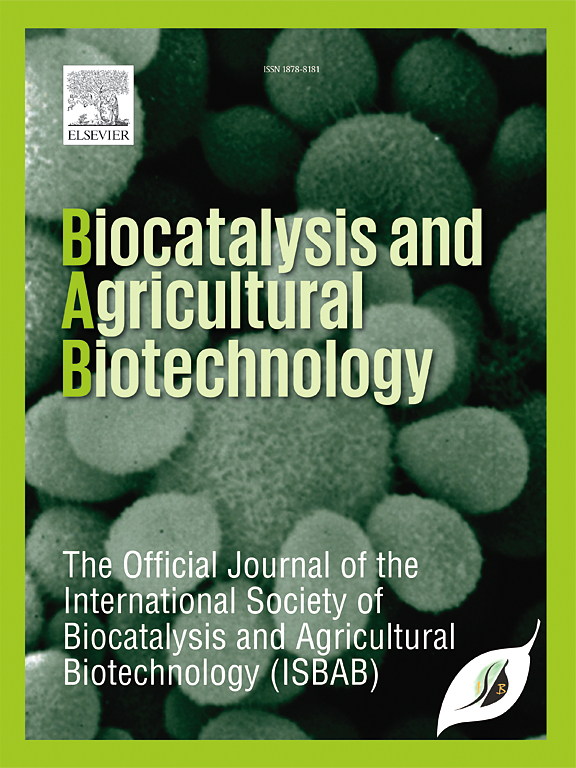决明子叶和茎皮的植物成分和生物活性:通过分子对接和体外方法研究其抗氧化能力和α-葡萄糖苷酶抑制作用
IF 3.4
Q2 BIOTECHNOLOGY & APPLIED MICROBIOLOGY
引用次数: 0
摘要
决明子是一种传统的药用植物,特别是在阿育吠陀和中医(TCM)中用于各种疾病。摘要本研究旨在评价野藿香叶和茎皮提取物及部位的抗氧化活性和α-葡萄糖苷酶抑制活性。采用甲醇提取金针藤叶和茎皮,茎皮提取物(BME)对α-葡萄糖苷酶的抑制作用优于叶提取物(LME),再用正己烷(BHF)、乙酸乙酯(BEAF)和甲醇(BMF)进行分馏。对提取物和馏分进行TPC、TFC、抗氧化能力(DPPH、FRAP和ABTS)、α-葡萄糖苷酶抑制、LC-HRMS和分子对接分析。BME的TPC和TFC值分别为38.23 mgGAE/g和98.41 mgQE/g,高于LME的3.12 mgGAE/g和4.46 mgQE/g,而茎皮馏分的TPC值为8.44 ~ 39.44 mgGAE/g, TFC值为33.62 ~ 121.86 mgQE/g。BME的抗氧化能力高于LME, BEAF的抗氧化能力高于其他馏分。BME对α-葡萄糖苷酶的抑制作用也高于LME, IC50值分别为2.81 μg/mL和60.48 μg/mL, BME各组分对α-葡萄糖苷酶的抑制作用范围为5.86 ~ 12.15 μg/mL。LC-HRMS鉴定出32种独特的化合物,包括酚类、类黄酮、类固醇、萜类、蒽醌和香豆素。槲皮素3- 0 -鼠李糖苷-7- 0 -葡萄糖苷通过分子对接与α-葡萄糖苷酶(PDB ID: 3A4A)的结合亲和力最高。综上所述,BME的抗氧化能力和α-葡萄糖苷酶活性均高于LME, BEAF的抗氧化能力高于其他馏分。本文章由计算机程序翻译,如有差异,请以英文原文为准。
Phytoconstituents and bioactivities of Cassia fistula leaf and stem bark: Antioxidant capacity and α-glucosidase inhibition via molecular docking and in vitro approaches
Cassia fistula is a traditional medicinal plant especially used in Ayuverdic and Traditional Chinese Medicine (TCM) for various diseases. This study aims to evaluate the antioxidant and α-glucosidase inhibition activities of extracts and fractions from C. fistula leaves and stem bark. C. fistula leaves and stem barks were extracted using methanol, and then stem barks extract (BME) further fractionated with hexane (BHF), ethyl acetate (BEAF), and methanol (BMF) due to its higher α-glucosidase inhibition than leaves extract (LME). Extracts and fractions were analyzed TPC, TFC, antioxidant capacity (DPPH, FRAP, and ABTS), α-glucosidase inhibition, LC-HRMS, and molecular docking of identified compounds. BME exhibited higher TPC and TFC values at 38.23 mgGAE/g and 98.41 mgQE/g compared to LME at 3.12 mgGAE/g and 4.46 mgQE/g, while stem bark fractions contain TPC values ranging from 8.44 to 39.44 mgGAE/g and TFC from 33.62 to 121.86 mgQE/g. BME exhibited higher antioxidant capacity than LME, while BEAF exhibited the highest antioxidant capacity compared to other fractions. Similarly, BME also exhibited higher α-glucosidase inhibition than LME, with IC50 values of 2.81 μg/mL and 60.48 μg/mL, respectively, while BME fractions α-glucosidase inhibition ranging from 5.86 to 12.15 μg/mL. LC-HRMS identified 32 unique compounds consisting of phenolics, flavonoids, steroids, terpenoids, anthraquinones, and coumarins. Among the identified compounds, quercetin 3-O-rhamnoside-7-O-glucoside demonstrated the highest binding affinity to α-glucosidase (PDB ID: 3A4A) trough molecular docking. These findings suggest BME possesses higher antioxidant capacity and α-glucosidase than LME, while BEAF showed the highest compared to other fractions.
求助全文
通过发布文献求助,成功后即可免费获取论文全文。
去求助
来源期刊

Biocatalysis and agricultural biotechnology
Agricultural and Biological Sciences-Agronomy and Crop Science
CiteScore
7.70
自引率
2.50%
发文量
308
审稿时长
48 days
期刊介绍:
Biocatalysis and Agricultural Biotechnology is the official journal of the International Society of Biocatalysis and Agricultural Biotechnology (ISBAB). The journal publishes high quality articles especially in the science and technology of biocatalysis, bioprocesses, agricultural biotechnology, biomedical biotechnology, and, if appropriate, from other related areas of biotechnology. The journal will publish peer-reviewed basic and applied research papers, authoritative reviews, and feature articles. The scope of the journal encompasses the research, industrial, and commercial aspects of biotechnology, including the areas of: biocatalysis; bioprocesses; food and agriculture; genetic engineering; molecular biology; healthcare and pharmaceuticals; biofuels; genomics; nanotechnology; environment and biodiversity; and bioremediation.
 求助内容:
求助内容: 应助结果提醒方式:
应助结果提醒方式:


